
|
These quirky keyboards belong to a very odd squarewave hardware class that was likely a predecessor of the Hing Hon EK-001 (see variant Transtec 893) and possibly MC-3. At the one hand it features accompaniment, programmable analogue rhythm and even a simple sequencer, but at the other hand the sound is plain squarewave with the most crude and primitive volume envelopes you can imagine; the whole thing is only 2 note polyphonic and the automatic single finger accompaniment features neither chords nor a separate bass line but simply occupies the 2nd melody voice with a monophonic pattern.
But these instruments are nothing bad; they sound just in a sympathetical way artificial and puristic and have much similarity with music from historical videogames or simple Commodore C64 homecomputer compositions. Especially the accompaniments sound nicely cheesy and innocent. The key response feels very direct, so like on a 1970th transistor organ you can play extremely short blip notes without getting into trouble with slow matrix scanning or too "intelligent" software that tries hard to prevent irregular sounding notes.
(Note: This thing sounds quite nice, but don't buy one of these so far your only intention is to get a keyboard with faithfully imitated natural instrument timbres. Remember, this is a squarewave instrument and its sounds do not even remotely resemble what is written on its buttons, thus bought with wrong expectation it may disappoint you.)

While the front panel of this instrument is labelled "MC-7", on the back of the case stands also the brand name "Pan Toys".
This instrument was also released as Elite MC-7, GPM MC-7 and Levis MC-7 (seen on eBay).
 (old eBay picture of my specimen.)
(old eBay picture of my specimen.) |
 |
 |
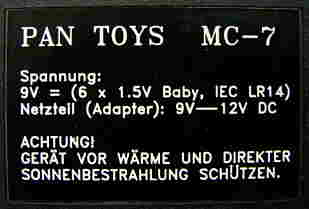 |
The sounds are extremely odd, because the timbres are just plain squarewave with different pulse widths and so archaic, crude volume envelopes that even a Letron or Casio VL-1 sounds almost natural against it. When sustain is switched off, after releasing the key any sounds stop immediately with an audible end click, and the sound presets itself also contain neither vibrato nor tremolo. The squarewave timbres are quite bright and some have a grainy purring texture; it is not zipper noise but sounds like an intermodulation with internal digital signals. When 2 notes are held, the timbre flutters with a strange irregular textures, which sounds quite interesting. Similar like the simple MC-11, this instrument permits (with some skill) to play extremely short, blipping notes those most modern keyboards ignore or render too long. The 'clarinet', 'violin', 'oboe' and even the 'elec. guitar' are nothing but plain squarewave tones of different pulse widths without any envelope (i.e. a simple toot or beep like from a cash register or similar). The 'piano' and 'harpsichord' have a decay envelope, but with sustain enabled they ignore the key press duration. The 'xylophone' is nothing else but a short beep (1/8s?, has same decay envelope that stays inaudible) with sudden end click, which stops without sustain even earlier by releasing the key, but also with sustain it won't get longer than its maximum length (which is much shorter than e.g. the 'piano' or any of the continuous tone sustains). The 'mandolin' of this little tablehooter even rings (about 8Hz), but like the latter it can also not be really prolonged by sustain. An oscilloscope reveals, that the 'violin' and 'e-guitar' have a purring texture made by the envelope trigger signal (seen in Fujiyama KS-37) that contains a texture looking like inverted 'mandolin' ring signal (i.e. steady level with short drops at 8Hz), which was likely intended as a tremolo, but the volume modulation stays almost inaudible by the fully charged envelope capacitor. The sustain duration with other preset sounds corresponds to the held 'piano' envelope. The vibrato button adds a 6Hz tremolo instead of a real vibrato.
Unlike the Letron and various similar squarewave keyboards, when OBS sound preset buttons are pressed with held down keys, this instrument does not immediately switch the timbre of the still sounding notes, but assigns the new selected sound either only to the next played notes or makes the held notes fade silent and then retriggers them with the new timbre. What exactly happens depends on the previous and new selected sound preset; e.g. a held "mandolin" note stops ringing as soon a different sound is selected. This can be used as a sound effect, although the behaviour can be difficult to predict.
Like the arpeggio of other instruments, the accompaniment can play in different keys despite it is monophonic; for this simply 1 or more keys in the left keyboard section have to be pressed, similar like a single finger chord (1 key= minor, 2 keys= major, 3 keys= 7th or the like). Although the accompaniment plays always the waveform of the currently selected main voice sound (including the vibrato setting), it turns it into an organ without decay envelope and uses no sustain; even the mandolin ring is strongly reduced.
Rhythms can be switched immediately and always (re-)start from their 1st step as soon any OBS rhythm button is pressed. With some skill this can be uses as a realtime variation feature. The rhythm only employs 2 dull analogue drums (like muffled congas with short decay envelope) and a hihat. With my first MC-7 the hihat sounded quiet like hit with too little force. Later I bought another Pan Toys MC-7 (to gut out for repairing my rare Fujiyama KS-37), which hihat sounded noticeably louder with more percussive attack (like a brushed snare); possibly one had a broken electrolytic cap or different discrete components.
The monophonic sequencer is useless because it holds only 28 notes and
does not work with rhythm (turns it off during record or playback). The
"custom drummer" otherwise can be combined with the preset rhythm accompaniments,
and even length of the drum pattern depends on the selected preset rhythm,
thus it is a quite interesting feature that may be good for tekkno. (The
analogue drums can be likely circuit-bent similarly like I did with my
HBATEC.)
Unfortunately the drumpads are monophonic and so can not play multiple
percussion simultaneously.
hardware detailsThe Pan Toys MC-7 is based on the single-chip CPU "SC-MC-2", which outputs 2 squarewave sound channels and trigger pulses for envelope and analogue percussion. The CPU analysis is also valid for other MC-2 based instruments.The PCB is rather small, and like the bizarre HBATEC it contains only one digital IC and lots of analogue stuff (mainly percussion).
The analogue envelopes are very primitive; they can only decay or stay absent. The envelope trigger pins 3, 4 control each a transistor circuit of a simple VCA and capacitors. There is no slow attack, thus the tone always starts immediately (with a soft key click) after key press. Without enabled sustain, the CPU stops the tone immediately after key release. With sustain on, in TrendLine MC 3700 and Fujiyama KS-37 the decay rate in some preset sounds is faster (by pulling CPU pins 18, 19 lo - not used in MC-7 and Medeli MC-2000A). Unfortunately even with sustain on, the CPU switches the tone generator off after 1s, thus no modification (except clocking the entire CPU and thus pitch lower) can make longer than 1s decay time. (It may be that in a prototype the VCA failed to completely mute a channel after decay and so this annoying decision was taken to prevent it from tooting in the background.) And (how stupid is that?!) the programmer missed the chance of using pin 18 or 19 for also shortening the 'piano' and 'harpsichord' sustain after key release; so they still ignore key press duration. (May be this was even the original intention of having 2 identically behaving pins for each a polyphony channel, but the programmer ran out of memory or time.) Continuous tones hold their envelope trigger pin active (lo) so long the key is pressed. Decaying tones only start with a short spike to charge the capacitor. The 'mandolin' envelope repeats this with 8Hz to make it ring. The 'mandolin' and 'xylophone' decays with the same rate like others, but stops the tone (not envelope) already after about 1/8s; that's why it sounds rather like a short beep, because the (barely percussive) envelope has no time to decay sufficiently. The envelope trigger signal of 'violin' and 'elec. guitar' is the inverted version of 'mandolin', i.e. it it has short gaps with 8Hz to make the level sink a little for a fast tremolo, which however is nearly inaudible because the fixed decay rate is way to slow to do much. So likely originally a faster decay was planned but not implemented. Such things are the strange little secrets of squarewave tablehooters those make it worth to analyze them, because they do differ from the theory of classic analogue synths in ways you don't expect. When the RC timing constant is shortened by modification (done here
in Fujiyama KS-37), the xylophone sounds more credible and the inverted
mandolin envelope adds a buzzy purr timbre to 'violin' and 'elec. guitar'.
But because this also makes e.g. 'piano' decay faster, extreme values are
of little use. (It might even be that instead of purr only a minor volume
reduction through a kind of PWM in some sounds was planned, but the
presence of a rhythm volume control makes this unlikely.)
With enabled vibrato, CPU pin 17 outputs a 6Hz LFO signal. Because the instrument is crystal clocked, the LFO simply modulates the transistor based VCA and thus produces rather a tremolo. The preset rhythms don't trigger hi and lo conga simultaneously. Traktor told me that in his Medeli MC-2000A a simplified drum circuit with a single oscillator for both drums is used (empty solder holes for the 2nd still exist), which only switches pitch when the higher drum is played. Strange is that in "custom drummer" mode not even even hihat can sound together with drums, so I expect that (like seen in Casio VL-1 patent) it stores each percussion step as a 2 bit number to save RAM space, i.e. any step can be only {pause, lo conga, hi conga, hihat} and thus can not play multiple percussion simultaneously. keyboard matrixThe matrix is based of my analysis of Fujiyama KS-37 (based on my too messy old handwritten documentation of TrendLine MC 3700).
The input lines are active-low, i.e. react on GND. Any functions can
be triggered by a non- locking switch in series to a diode from one "in"
to one "out" pin. Very unusual is that the keyboard matrix inputs of this
CPU respond only on rather low resistance voltages (about 330 Ohm).
There are 3 additional low bass note keys addable at pins 27->34, 28->34 and 29->34. Unlike normal low note keys, these don't affect accompaniment and have (depending on selected preset sound) a changed pulse width (in some sounds 28->34 differs again), so they may be a bug or test feature. The drumpads behave a bit odd. They are only monophonic (despite preset rhythms can play hihat simultaneous with a drum). When a 2nd pad is held, it will sound only after the 1st pad is released. pinout SC-MC-2The "SC-MC-2" (42 pin DIL) by Medeli is the CPU of the MC-2 series keyboard hardware class. It has internal ROM and outputs 2 squarewave sound channels and trigger pulses for crude capacitor envelope and for 3 analogue percussion. This is one of the most basic home keyboard CPUs with accompaniment, because instead of chords it only uses the 2nd melody voice channel for a kind of arpeggio.It is likely the same OKI microcontroller like MC-3DX (which uses an external sound IC) of the famous MC-3 keyboards with changed software to produce tones by itself. Historically important is the lower number, which hints that this was either a predecessor or cheaper variant made by Medeli. This pinout is based on my analysis of Fujiyama
KS-37, my old handwritten description of TrendLine
MC 3700, PCB photos of MC-7 and few guesses from MC-3DX.
The pin names were taken from the "SC-MC-3"
pinout in book "Keyboard Principles" (typos fixed by OKI MSM6404VS
datasheet) and line names chosen by me to describe their functions (partly
inspired by Casio naming conventions).
CPU pin 18 and 19 both are hi during the preset sounds {violin, harpsichord, e-guitar, piano}. Strange is that in my Fujiyama KS-37 their hi level is only +2.5V, which likely was result of CPU overvoltage damage, because in MC-7 (which does not use them) it is regular +5V. In the KS-37 only pin 18 goes to a transistor circuit that apparently connects an additional 1uF capacitor to the envelope section. In Trend Line MC3700 both pins are used, which may be the reason why 2 simultaneous notes here do not cause long sustain. Preset sounds {violin, e-guitar} show the inverted mandolin ring pattern on their envelope pins, which was likely intended as tremolo or to lower the output volume. During vibrato pin 17 outputs a squarewave LFO signal. Pin 8 is hi during each accompaniment note that is played or would be played (i.e. when rhythm is running, also when accomp=off); likely this was designed as an envelope trigger, but not used because it stays on when accomp=off (may be masked out using the signal from pin 22). The unused pins 13..15 stay hi with high resistance, thus they are likely unused inputs. When the CPU locks up by empty batteries, it mutes both polyphony channels and controls do not respond anymore, but the selected rhythm keeps running. This hints that its hardware (or IRQ routine without RAM?) can loop a bit pattern on an output port by itself even when the rest (RAM contents?) has crashed. Close successors of this CPU were the SC-MC-21/SC-MC-22, those implement additional 3 note polyphonic accompaniment and better envelope control. Unlike the (Zilog based) "KZ" CPUs of Angeltone hardware (like HBATEC, Fujitone 3-A), the entire Medeli "MC-SC" CPU series has percussion trigger and LED outs not embedded into their keyboard matrix but on separate pins, which strongly hints that they were designed by different programmers. MC-SC also seem more precisely tailored for the instruments they are used in, and so have fewer interesting eastereggs. |
Besides that it is much bigger (midsize keys), the MC-7 case design resembles very much Hing Hon EK-001, and indeed also a mini keys version of it was released as Elite MC 2000, Transtec 893 and Grand Prix KB 893, which case looks besides the different button layout exactly like my EK-001. A case variant of the MC 2000 with centered drumpads shaped like Casio SK-5 and SK-8 was released as Fujitone II and Monacor MC-2000A (see below).
Very unusual is that this instrument has no master volume control, but only 2 separate "faders" for main voice and rhythm volumes, those behave totally independent (i.e. reducing the "main volume" does not also reduce the rhythm volume).
Due to strong similarities, I only discuss here the differences to Pan Toys MC-7.
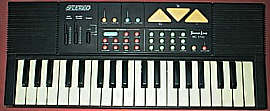
(old eBay photo of my specimen) |
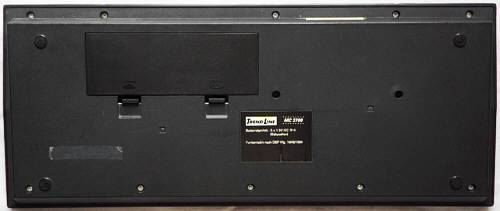 |
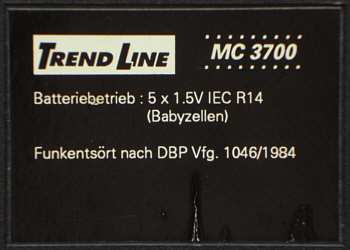 |
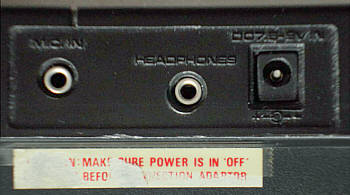 |
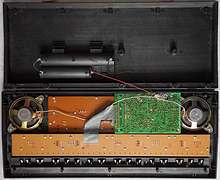 |
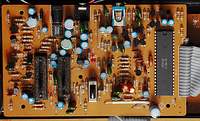 |
This instrument was also sold as Bestar MC 3700, Mundia MC-3700
MP180, XJ 37 F 370 and Kamosonic F1. The case design
of this instruments has many style elements common with the MC-3
keyboard Tristar MC 3000 and the GPM
MC-5000.
This was my first specimen that I found of the MC-2 hardware class. It was sold to me on flea market and seems to be ultra-rare, but unfortunately mine was completely brain-dead; apparently someone before me confused the AC-adapter polarity and though toasted it, or the dead zener diode killed it by overvoltage. The only still working parts were the amp and the transistorized analogue drum circuit. Later I repaired it with parts from a Pan Toys MC-7.
The case is brown and the speakers are left and right next to the keyboard instead of above it ( =>wastes space). It has 3 orange drum pad buttons and most other controls are similarly labelled like the Letron, but the keys are slightly longer than normal midsize keys. The instrument has a nicely warm timbre and slightly better envelope hardware than MC-7. Annoying is that volume can not be set lower than medium ambient volume. Due to strong similarities, I only discuss here the differences to Pan Toys MC-7.
This instrument was also released as Tokyo KS-37 (seen on eBay).
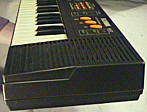 The
slightly slanted side speakers are a well recognizable style element of
this case; I believe to remember that old Fujitone keyboards featured
them also. The
slightly slanted side speakers are a well recognizable style element of
this case; I believe to remember that old Fujitone keyboards featured
them also. |
 The
drumpads have wrong icons {base, snare, open hihat}; genuinely they play
{lo conga, hi conga, closed hihat}. Shape resembles Hing
Hon EK-001. The
drumpads have wrong icons {base, snare, open hihat}; genuinely they play
{lo conga, hi conga, closed hihat}. Shape resembles Hing
Hon EK-001. |
 |
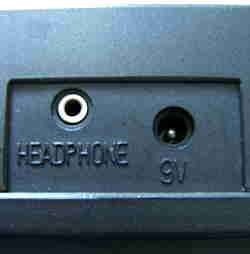 |
 |
The Fujiyama KS-37 looks quite much like what I remember from
my childhood as a "Fujitone". I would love to find one of these
first Fujitones (not a Fujitone
IIIb but a really old one). A variant of the Fujiyama KS-37
with similar case but more rectangular speakers and drumpads was apparently
released in China with the brand name
Tongmei (not Yongmei,
seen on
eBay).
hardware detailsAlso the Fujiyama KS-37 is based on the single-chip CPU "SC-MC-2".
noise reductionAfter repair it worked well now but there was still much mains hum because the GND line was wired very badly; the entire ground current of the supply voltage was drawn through the audio GND line at the volume potentiometers and thus caused a voltage drop. I separated both grounds and wired the audio and audio GND lines separately with a shielded cable to the amp section =>hum is gone. Initially also the left speaker had wrong polarity, but wiring it correctly didn't boost the bass response really much.envelope decay controlThe envelope decay control from CPU pin 18 goes to transistor Q6, which connects the electrolytic cap C9 (1uF) with the VCA transistor Q8 to make sustain decay slower if pin 18=hi.In my KS-37 the envelope decay was too slow, which e.g. blurred the mandolin ring pulses. The resistor R21 controls the decay rate of the envelope circuit. Reducing it makes it decay faster, so I wired [a 100k trimmer in series with a 10k (safety) resistor] parallel with R21. With my specimen a total value of 25K sounds like the best compromise for 'xylophone' and mandolin'. But this method is not perfect; during 2 simultaneous notes the sustain still sounds too long (by charging a capacitor too much?). You may install a potentiometer with the right end of the carbon trace cut to keep the original value when turned rightmost. Regard that you can not make decay time longer than it is, because the CPU switches the waveform off after 1s (1/8s in 'xylophone' and 'mandolin'), so slower decay only emphasizes the end click because volume falls less before the tone stops. |
 Transtec 893
Transtec 893
same case:
This was the direct predecessor of
|

Fujitone 2 (Fujitone II) same case:
|


Tongmei |
| removal of these screws voids warranty... | ||
 |
||
|
|